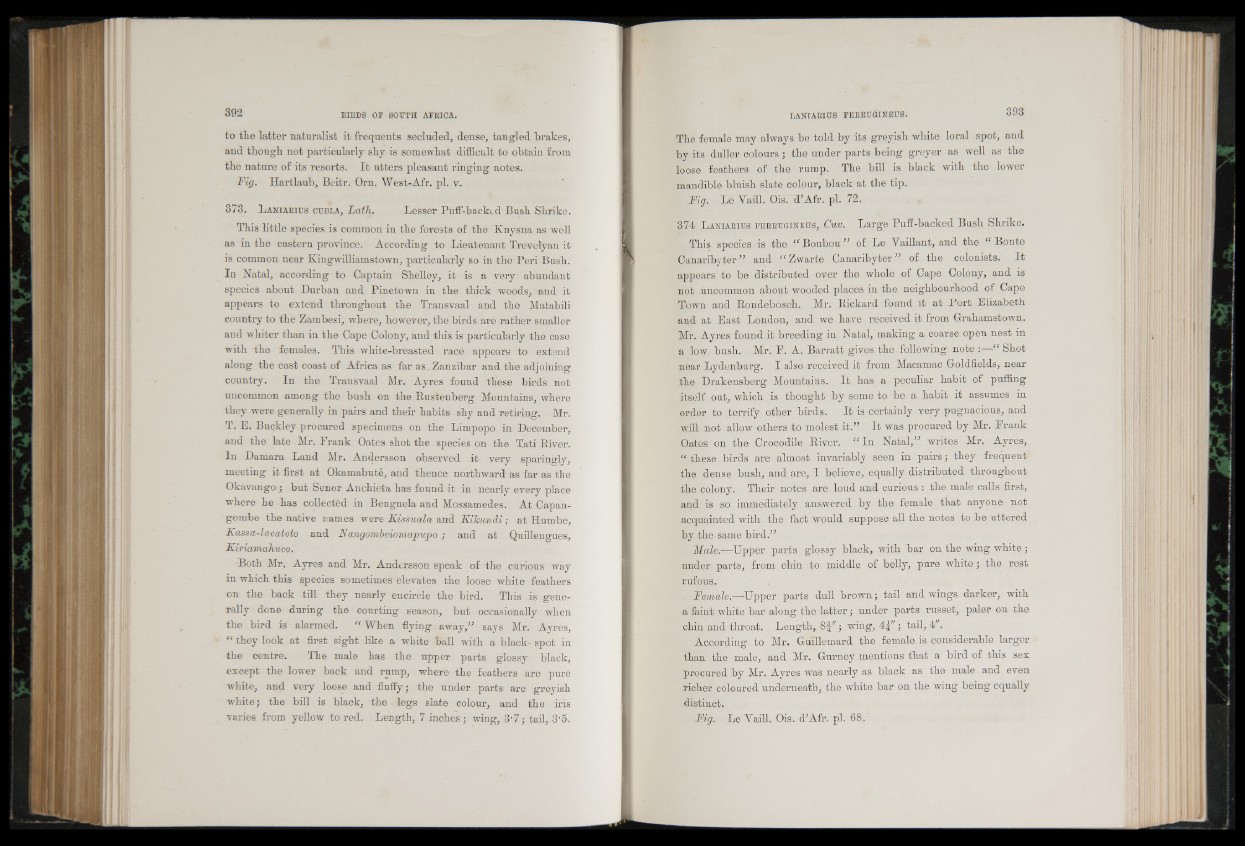
to the latter naturalist it frequents secluded, dense, tangled brakes,
and though not particularly shy is somewhat difficult to obtain from
the nature of its resorts. It utters pleasant ringing notes.
Fig. Hartlaub, Beitr. Orn. West-Afr. pi. v.
373. L a n i a r i u s c u b l a , Lath. Lesser Puff-backed Bush Shrike.
This little species is common in the forests of the Knysna as well
as in the eastern province. According to Lieutenant Trevelyan it
is common near Kingwilliamstown, particularly so in the Peri Bush.
In Natal, according to Captain Shelley, it is a very abundant
species about Durban and Pinetown in the thick woods, and it
appears to extend throughout the Transvaal and the Matabili
country to the Zambesi, where, however, the birds are rather smaller
and whiter than in the Cape Colony, and this is particularly the case
with the females. This white-breasted race appears to extend
along the east coast of Africa as far as, Zanzibar and the adjoining
country. In the Transvaal Mr. Ayres found these birds not
uncommon among the bush on the Rustenberg Mountains, where
they were generally in pairs and their habits shy and retiring. Mr.
T. E. Buckley procured specimens on the Limpopo in December,
and the late Mr. Frank Oates shot the species on the Tati River.
In Damara Land Mr. Andersson observed it very sparingly,
meeting it first at Okamabute, and thence northward'as far as the
Okavango ; but Senor Anchieta has found it in nearly every place
where he has collected in Benguela and Mossamedes. At Capan-
gombe the native names were Kissuala and Kihundi ; at Humbe,
Kassa-laeatoto and Nangombeiomapupoand at Quillengues,
Kiriamahuco.
Both Mr. Ayres and Mr. Andersson speak of the curious way
in which this species sometimes elevates the loose white feathers
on the back till they nearly encircle the bird. This is generally
done during the courting season, but occasionally when
the bird is alarmed. “ When flying away,” says Mr. Ayres,
“ they look at first sight like a white ball with a black- spot in
the centre. The male has the upper parts glossy black,
except the lower back and rump, where the feathers are pure
white, and very loose and fluffy; the under parts are greyish
white; the bill is black, the legs slate colour, and the iris
varies from yellow to red. Length, 7 inches; wing, 3*7; tail, 3’5.
The female may always be told by its greyish white loral spot, and
by its duller colours ; the under parts being greyer as well as the
loose feathers of the rump. The bill is black with the lower
mandible bluish slate colour, black at the tip.
Fig. Le Vaill. Ois. d’Afr. pi. 72.
374 L a n i a r i u s f e r r u s i n e u s , Cu v . Large Puff-backed Bush Shrike.
This species is the “ Boubou” of Le Vaillant, and the “ Bonte
Canaribyter ” and “ Zwarte Canaribyter ” of the colonists. It
appears to be distributed over the whole of Cape Colony, and is
not uncommon about wooded places in the neighbourhood of Cape
Town and Rondebosch. Mr. Rickard found it at Port Elizabeth
and at East London, and we have received it from Grahamstown.
Mr. Ayres found it breeding in Natal, making a coarse open nest in
a low bush. Mr. P. A. Barratt gives the following note :—“ Shot
near Lydenburg. I also received it from Macamac Goldfields, near
the Drakensberg Mountains. It has a peculiar habit of puffing
itself out, which is thought by some to be a habit it assumes in
order to terrify other birds. It is certainly very pugnacious, and
will not allow others to molest it.” It was procured by Mr. Frank
Oates on the Crocodile River. “ In Natal,” writes Mr. Ayres,
“ these birds are almost invariably seen in pairs; they frequent
the dense bush, and are, I believe, equally distributed throughout
the colony. Their notes are loud and curious : the male calls first,
and is so immediately answered by the female that anyone not
acquainted with the fact would suppose all the notes to be uttered
by the same bird.”
Male.—Upper parts glossy black, with bar on the wing white;
under parts, from chin to middle of belly, pure white; the rest
rufous.
Female.—Upper parts dull brown; tail and wings darker, with
a faint white bar along the latter; under parts russet, paler on the
chin and throat. Length, 8 |w; wing, 4 jw; tail, 4W.
According to Mr. Guillemard the female is considerable larger
than the male, and Mr. Gurney mentions that a bird of this sex
procured by Mr. Ayres was nearly as black as the male and even
richer coloured underneath, the white bar on the wing being equally
distinct.
Fig. Le Vaill. Ois. d'Afr. pi. 68.